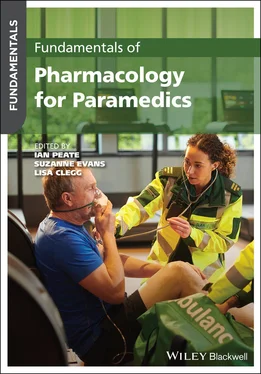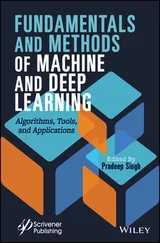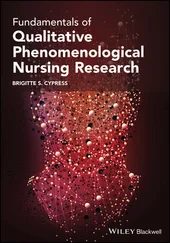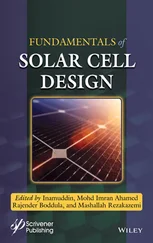1 ...6 7 8 10 11 12 ...21
| Abbreviation |
Latin |
English |
| a.c. |
ante cibum |
Before food |
| ad lib. |
ad libitum |
To the desired amount |
| b.d. or b.i.d. |
bis in die |
Twice a day |
| c. |
cum |
With |
| o.m. |
omni mane |
Every morning |
| o.n. |
omni nocte |
Every night |
| p.c. |
post cibum |
After food |
| p.r.n. |
pro re nata |
Whenever necessary |
| q.d. |
quaque die |
Every day |
| q.d.s. |
quaque die sumendum |
Four times daily |
| q.i.d. |
quater in die |
Four times daily |
| q.q.h. |
quater quaque hora |
Every four hours |
| R. |
recipe |
Take |
| s.o.s. |
si opus sit |
If necessary |
| stat. |
statim |
At once |
| t.d.s. |
ter die sumendum |
Three times daily |
| t.i.d. |
ter in die |
Three times daily |
Chapter 1 Introduction to pharmacology
Suzanne Evans and Tanya Somani
The aim of this chapter is to provide an introductory overview of the aspects of pharmacology that are important for paramedic practice.
After reading this chapter, the reader will:
1 Be aware of the potential for error in every stage of drug administration, and strategies to avoid medication error.
2 Be able to distinguish the generic and trade names of drugs, and know the conventions for generic names of drugs in the same class.
3 Know the range of sites at which the majority of drugs act to produce their effects.
4 Understand the importance of correct choice, dosing and administration of a drug.
1 Which medicines are considered to be completely safe?
2 How can the risk of accidental harm from medicines be reduced?
3 When taking a medication history, what should you prompt a patient to include?
4 What is the generic name and what is the trade name of a medication and where is each name located on the packaging?
Pharmacology is the study of medications. It includes the study of how and when to use them safely and effectively, as well as the search for and the development of new and more effective medications. Although in paramedicine, the term ‘medication’ is often used in reference to therapeutic agents and the term ‘drug’ in reference to illicit agents, in this chapter we will use the term ‘drug’ with the broader meaning of ‘any substance that produces a change in physiological function’ when discussing the pharmacology of the active substances rather than formulated preparations.
Health practitioners have at their disposal a formidable armoury of powerful pharmacological agents which have the ability to save lives and relieve suffering. These same agents, used incorrectly, are equally capable of causing death, suffering and irreparable damage. The use of these powerful tools comes with a responsibility to know how to use them safely, and to have a deep understanding of what they can do. Paramedics, often called on to select and correctly use medications in uncontrolled environments with the additional pressures of time and stress, have an even greater need to be experts in the medicines they will administer, performing, as they do, the roles of physician, pharmacist and nurse in the field. Add to this a constantly evolving scope of practice in paramedicine, and it can be seen that the expectations placed on paramedics in the practice of pharmacotherapeutics are very high.
Medication errors in healthcare generally are a significant problem, accounting for a large number of hospitalisations and deaths per year. In prehospital care in particular, medication errors are thought to be significantly under‐reported (Batt, 2016; Hobgood et al. 2006; Lammers et al. 2014; Nguyen, 2008). Data from a number of studies on medication errors in Australian hospitals suggested that between 5% and 10% of administrations may be made in error (Roughead et al., 2013), and in England alone, more than 237 million medication errors are made every year (Elliott et al., 2018). Medication errors made in all areas of healthcare are a similar concern in the United States, the European Union, and in most countries of the world. In recognition of the problem, in 2017 the World Health Organization launched a global initiative to reduce severe, avoidable medication‐associated harm worldwide by 50% over 5 years.
Medication errors in paramedicine can include the general misuse of a medicine, such as administering the wrong dose, using the wrong administration route, or failing to identify contraindications. But, because the paramedic is responsible for all phases of the administration of the medication, including the selection of the appropriate medication and the decision about whether and when to use it, two other types of error can also occur: under‐ or overuse of medicines. The failure to use a medication that could be of benefit to a patient, such as failing to give aspirin for acute coronary syndrome, would be considered an error of underuse, while using an unnecessary medication, or using a second medication to treat a side‐effect produced by the first medication, could be considered errors of overuse (Batt, 2016).
The Institute of Safe Medication Practices (ISMP) Canada, in its 2020 safety bulletin, reported on a multi‐incident analysis of medication incidents involving paramedicine. This analysis identified the following five main themes in medication errors in paramedicine:
1 The clinical assessment and management of patients, including taking a complete medical and medication history.
2 Therapeutic product use, including misreading of labelling or mistaking products with similar packaging.
3 Intravenous dosing and administration, including calculating dose and setting up pumps.
4 Handover communications, including communication to hospital personnel.
5 Inventory management, including correct restocking of the ambulance with medication and correct positioning of drugs.
These themes serve to reinforce the multiple responsibilities of paramedics when it comes to administering medicines – paramedics are responsible for taking a complete patient history, calculating a correct dose and administering the medication correctly, right through to ensuring the medication is in the ambulance in the correct place before going out on the road. The scope for medication error increases with each layer of responsibility.
A number of authors have suggested standard methodologies to ensure that the correct approach to medicines use is followed every time, especially under high‐stress conditions. The following mnemonic for the assessment of patients was developed by ISMP Canada:
Signs
Allergies
Medication
Past pertinent history
Last oral intake
Events leading to injury
Students of paramedicine are usually familiar with the golden rules of safe administration of medicines, published as 10 golden rules (McGovern, 1992) but also appearing in shortened forms. These rules stipulate that when giving any medication:
1 Give the right drug
2 To the right patient
3 In the right dose
4 Via the right route
5 At the right time
6 Explain about the medication to your patient
7 Take a complete medication history
8 Find out about any allergies
9 Know about potential drug interactions
10 Document each medication administration.
Читать дальше












